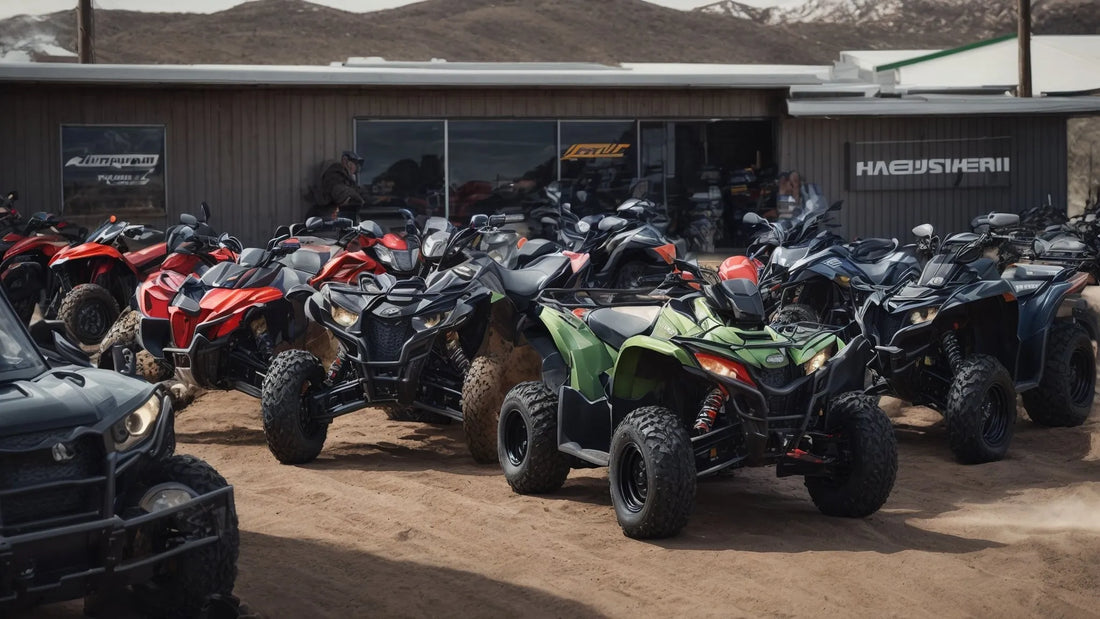
What Beginners should Know before buying All Terrain Vehicles
Q9powersportsusa.com StaffShare
All Terrain Vehicles: Exploring the Basics
All Terrain Vehicles (ATVs) have gained popularity in recent years, offering an exciting and adventurous way to explore the great outdoors. If you're a beginner looking to delve into the world of ATVs, there are a few key points to keep in mind before you hit the trails.
1. Safety First
Before you hop on an ATV, it's crucial to prioritize safety. Always wear a helmet, goggles, and appropriate protective gear. Familiarize yourself with the ATV's controls and ensure you have proper training to handle the vehicle. Additionally, follow all local laws and regulations regarding ATV use.
2. Choose the Right ATV
When starting out, it's important to select an ATV that matches your skill level. ATVs come in various sizes and power levels, so opt for a model that you can comfortably handle. Consider factors such as engine size, weight, and terrain capabilities when making your decision.
3. Practice Makes Perfect
Like any new skill, mastering ATV riding requires practice. Start by familiarizing yourself with the vehicle in a controlled environment, such as an empty parking lot or designated off-road area. Gradually increase your skill level and confidence before tackling more challenging terrains.
4. Respect the Environment
When riding an ATV, it's essential to respect the environment and follow responsible off-roading practices. Stick to designated trails, avoid damaging vegetation, and be mindful of wildlife. By preserving the natural beauty, you can ensure the longevity of ATV riding for future generations.
5. Maintenance and Upkeep
Proper maintenance is crucial for the longevity and safety of your ATV. Regularly inspect and service your vehicle according to the manufacturer's guidelines. This includes checking tire pressure, brakes, and fluid levels. By keeping your ATV in good condition, you'll enjoy a smoother and safer riding experience.
6. Safety Precautions
While riding an ATV, it's important to follow additional safety precautions. Avoid riding alone, as having a companion can provide assistance in case of an emergency. Always inform someone about your riding plans and expected return time. Carry a first aid kit, emergency supplies, and a cellphone for communication.
7. Riding Techniques
Understanding proper riding techniques is vital for a safe and enjoyable ATV experience. Learn how to shift your body weight to maintain balance and control. Use the handlebars to steer while keeping your feet firmly planted on the footrests. Start with slow speeds and gradually increase as you gain confidence.
8. Terrain Considerations
Different terrains require specific skills and precautions when riding an ATV. For example, riding on sand dunes necessitates maintaining momentum and avoiding sudden turns. Riding on rocky terrains requires careful maneuvering and selecting appropriate lines. Research and learn about the specific challenges and techniques for the terrain you intend to ride on.
9. Riding Etiquette
Respecting other riders and trail users is essential when riding an ATV. Yield to hikers, horseback riders, and cyclists. Slow down or stop when encountering other vehicles on narrow trails. Avoid excessive noise and maintain a reasonable speed to minimize disturbances in natural areas.
10. Expand Your Knowledge
Keep learning and expanding your knowledge about ATVs. Attend ATV safety courses and workshops to enhance your understanding of riding techniques, maintenance, and safety practices. Engage with experienced riders and join ATV communities to gain valuable insights and tips.
11. Legal Considerations
Before venturing out on your ATV, familiarize yourself with the local laws and regulations governing ATV usage. Some areas may have restrictions on where you can ride or require permits. Understanding and adhering to these rules will ensure you have a hassle-free and compliant riding experience.
12. Weather Awareness
Weather conditions can greatly impact ATV riding. Be aware of weather forecasts and avoid riding in extreme conditions such as heavy rain, snow, or strong winds. Slippery or muddy trails can pose additional challenges, so adjust your riding style accordingly.
13. Group Riding
Participating in group rides can be an enjoyable way to explore new trails and connect with fellow ATV enthusiasts. However, it's important to maintain proper group riding etiquette. Follow the lead of the group leader, maintain a safe distance between ATVs, and communicate effectively using hand signals or communication devices.
14. Insurance Coverage
Consider obtaining insurance coverage specifically designed for ATVs. This coverage can protect you in case of accidents, injuries, or damage to your ATV. Consult with insurance providers to understand the available options and choose a policy that suits your needs.
15. Environmental Impact
ATVs have the potential to impact the environment, especially in fragile ecosystems. Be mindful of sensitive areas, such as wetlands or protected wildlife habitats, and avoid riding in these areas. Minimize your carbon footprint by choosing fuel-efficient models and practicing eco-friendly habits both on and off the trails.
Conclusion
ATVs offer an exhilarating way to explore the great outdoors, but it's essential for beginners to approach this hobby with caution. Prioritize safety, choose the right ATV, practice regularly, respect the environment, maintain your vehicle properly, follow additional safety precautions, and stay informed about legal considerations and weather conditions. By following these guidelines and continuously expanding your knowledge, you'll be well-prepared to embark on thrilling ATV adventures while ensuring your own safety and the preservation of nature.
